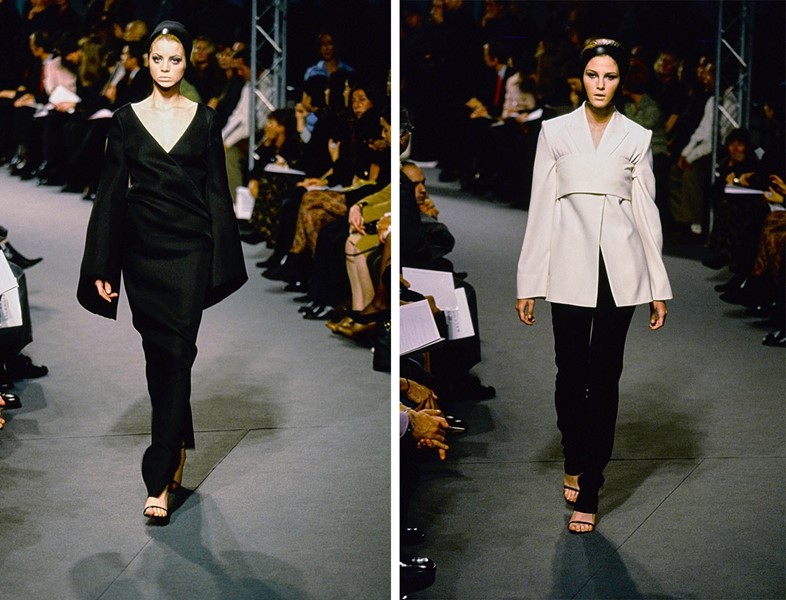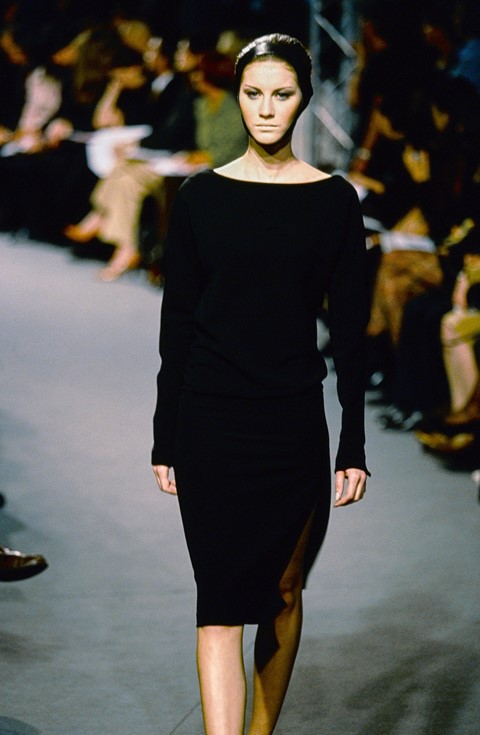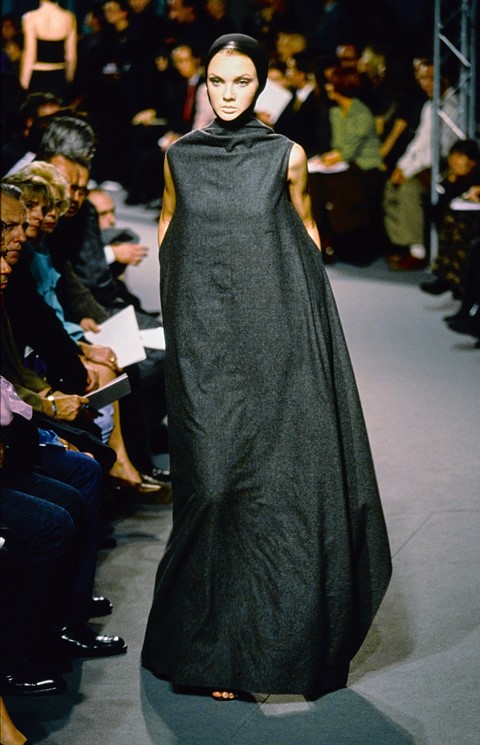As Balenciaga: Unveiling Fashion opens this weekend, we take a look at Nicolas Ghesquière’s monastic and minimalistic debut at the brand
As the fashion world prepares for this Saturday’s unveiling of the V&A’s new blockbuster, Balenciaga: Unveiling Fashion, we take a look at one of the key turning points in the brand’s history: creative director Nicolas Ghesquière’s debut collection. The epic new exhibition charts the brand’s 100-year story since Cristóbal Balenciaga – known as the Master of Haute Couture – opened his first, eponymously named fashion house in San Sebastian, Spain. The brand has since enjoyed numerous incarnations at the hands of Balenciaga’s multiple successors since the founder’s death in 1972, including Josephus Thimister, Alexander Wang and today’s creative director Demna Gvasalia. However, it’s Ghesquière’s first collection for the brand that marks a particular renaissance in the fashion house’s history, a moment where, according to WWD, Ghesquière began the ailing label’s rebuild and became “one of the stars of the brand reinvention era”.
Having interned for a couple of years at Jean-Paul Gaultier in his early twenties, Ghesquière took to freelance design contracts before his friend – ex-lover and shoe designer Pierre Hardy – told him about a freelance position at Balenciaga. Though his friends warned him off of the “dusty old fashion house” that had lagged somewhat since Balenciaga’s death, Ghesquière was keen to acquire a new client. Aged 22, the young designer joined the Japanese licensing department where he designed wedding dresses and funeral wear. When his creative director Thimister was fired unceremoniously in 1997, Ghesquière was crowned creative director, despite having expected Helmut Lang to take the helm instead, and he was left with less than four months to design the S/S98 show. With that, the brand’s new lease of life began.

The Show
“I could see, by watching the contemporary collections and also trying to learn about fashion history, that there was a strong connection between the work of the 90s minimalists – Helmut Lang and Jil Sander – and Cristóbal Balenciaga,” Ghesquière has said of his approach at the time. What emerged on his catwalk that day was a hybrid of sleek minimalism and couture drama: 51 girls draped and cloaked in soft black jersey and sculpted leathers (bar two standout white pieces), each look was completed with a leather chin-strapped headband, redolent of those swaddling hoods that appeared in techno fabrics on Gvasalia’s Balenciaga runway for A/W17.
Balenciaga’s legacy fed through the looks, despite the odds being against Ghesquière: “I hate watching the video now,” he says now of that runway show. “They [the company] wanted the Opéra Bastille – wrong venue. They wanted the girls to walk in a circular thing – didn’t fit. Even the carpet was bad. When you’re a newcomer in Paris, the Chambre Syndicale puts you between two huge designers. You have no chance to get good girls, and the press is too busy to come. I hated that show but still love the clothes. I approached Balenciaga in the most religious way possible: very black, very monastic, a sharp line.” And with those lines, Ghesquière recalled the controversial shapes of Balenciaga’s sack dresses and puff ball shapes that had upended the popular New Look silhouette of his time. Contrasting these shapes with on-point, 90s minimalist tropes – low-slung cigarette pants, spaghetti strap dresses and sculpted kimono shapes – he offered startling newness and set the tone for a 15-year career at the house he reinvented.

The People
Brazilian supermodel Gisele Bündchen ushered in the end of the waif model era in the late 90s. Her athletic shape and glossy tan introduced a new kind of beauty that quickly bewitched the fashion world and introduced the blonde bombshell look that put the nail in the coffin of heroin chic. Bündchen’s big break came the very same season as Ghesquière's debut, where she joined the ranks of the strong, statuesque girls on his Balenciaga runway.
Having only flown over to Europe in 1997, Bündchen auditioned for 42 shows for the S/S98 season and it was at Alexander McQueen’s show that the South American model made a stir, walking in towering heels across a slippery, rain-strewn runway. McQueen dubbed her “the body” and the rest was history – cue a British Vogue cover in 1998, campaigns for Missoni, Chloé, Dolce & Gabbana, Valentino, Gianfranco Ferré, Ralph Lauren, and Versace that same year and a slew of cover options to follow in the next four years as she became one of the most in-demand models of the 2000s. The 17-year-old Bündchen was the star of Ghesquière’s show and marked the beginning of his push for fresh faces, that which continues today at Louis Vuitton, where he has introduced the likes of Jean Campbell, Rianne van Rompaey, and the pink-haired Fernanda Ly to the world stage.

The Impact
Within a year of the designer’s debut as creative director, most of the global luxury groups were queuing to recruit him. “There were 15 days of my professional life when everyone called: Bernard Arnault [LVMH], Patrizio Bertelli [Prada], Tom Ford and Domenico De Sole [Gucci]. They all said: ‘We’ll give you whatever you want. Another house? Your own label?’” Ghesquière recently explained. Instead, the designer stayed put while Gucci Group and PPR wrestled over the company and, creating the still wildly popular Lariat bag and a pair of heavy-metalled, cut-out biker boots, went on to become one of the most influential fashion voices of the 2000s.
“Chloë Sevigny probably owes her entire career as a radical style chick to his early designs at Balenciaga. He put the planet on skyscraper platforms,” wrote Cathy Horyn for the New York Times when Ghesquière signed to Louis Vuitton in 2014. Throughout his time at the brand, his lego-brick heels, drop-crotch cargo pants, gladiator sandals and armour-like leggings spurred trends through catwalks and high street retailers alike. As Lisa Armstrong wrote when he took his latest role, “There’s no argument that Ghesquière turned Balenciaga into one of the most talked-about labels of the 00s during his tenure – something it hadn’t been since the Basque-born Cristóbal Balenciaga closed the doors of his house in 1968 with the weary utterance that ‘there were no more women left to dress’.” It seems that Ghesquière resurrected a few.
